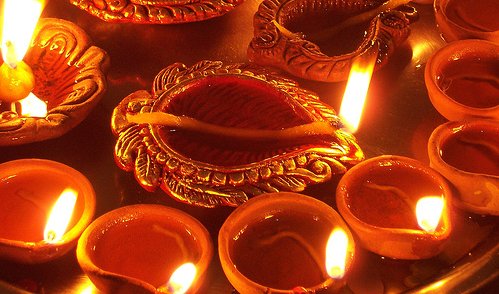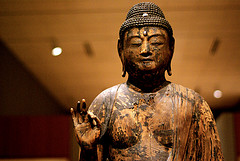 |
| (Image by dhondusaxena) |
While Buddha, Mahavira and Gosala were the famous Indian enlightened souls of the axial age, they were not the only ones. Ordinary folks had numerous options; they could believe in materialism following Ajita Kesakambali, eternalism following Pakudha Kacca-yana or become agnostic following Sañjaya Belaṭṭhaputta. It was not just a time of great material wealth, but also of a vibrant spiritual market and a common sight in those times were parivrajakas or wanderers preaching their doctrines and engaging rivals in debates in kautuhala salas built for the purpose. Philosophy was so addictive at that time that when people greeted strangers, they not only asked about their health, but also their spiritual doctrine.[1]
Modern American religious landscape is dynamic too. According to the U.S. Religious Landscape Survey, based on interviews with 35,000 people, 28% of American adults left the religion of their childhood for another one and the number becomes 44% if a switch from one version of Protestantism to another is included. The number of people unaffiliated with organized religion is 16% and this group which claims to be spiritual, but not religious has seen the largest growth. This is not just the time of the Facebook crowd, but also of the church hoppers.
The great news is that most Jehovah’s Witnesses, those irritating people who knock on your door violating laws and privacy, moved out of their faith, but unfortunately were balanced by new converts. The winners of the osmosis were the unaffiliated ones who saw a growth of 8.8% and the next came the nondenominational Protestants. The losers include Baptists (3.7%) and Methodists (2.1%), but still the biggest loser was the Catholic Church (7.5%).. The number of Catholics fell from one-third to one-fourth and a large Catholic migrant population, mainly Latinos could not put Humpty Dumpty together again.
People switched religious affiliations because they were looking for different goods depending on where they were in their life. Some wanted churches which focus on services and others wanted comfort and solace or help in raising their children the right way; a few switched for theological reasons. There are other explanations as well. During childhood, parents forced the kids to attend a religious group which was their cultural center, but as they moved out and became individualistic, they looked for religions that addressed their needs and abandoned the ones which did not.
To appreciate this religious tolerance, one has to look at the parlous time in American history when being a member of the wrong denomination could mean death. Europeans of the 17th century believed that there was one true religion and the authorities had to enforce it and punish the non-conformers. The people who faced persecution in Europe came to United States and practiced a Procrustean religious policy. The “business” of the first settlers, a Puritan minister recalled in 1681, “was not Toleration, but [they] were professed enemies of it.”
In 1658, the Massachussets legislature passed a law which allowed any constable to arrest and imprison every Quaker and banish them upon pain of death. The Boston martyrs, Marmaduke Stephenson, William Robinson and Mary Dyer were killed just because they were not Puritans.
 From there we have a reached a time when non-followers of Abrahamic religions are welcomed and are able to do well in the American society. Indic religions do not have a vast following with Buddhists forming 0.7% and Hindus, 0.4%. Among the Buddhists only 32% came from Asia whereas Hindus were predominantly from Asia and four times more Hindus migrated to United States after 1989 than those that arrived before 1960.
From there we have a reached a time when non-followers of Abrahamic religions are welcomed and are able to do well in the American society. Indic religions do not have a vast following with Buddhists forming 0.7% and Hindus, 0.4%. Among the Buddhists only 32% came from Asia whereas Hindus were predominantly from Asia and four times more Hindus migrated to United States after 1989 than those that arrived before 1960.
Even with low numbers these groups reached the top of certain categories. Hindus and Buddhists lead the religious groups in terms of education and were most likely to have a post-graduate degree. In the income category, Hindus along with Jews were the toppers. Hinduism had the highest retention rate (9/10 remained Hindu) and strong marriages (5% divorce rate). 90% of the Hindus married a Hindu, thus leading that category as well.
The survey also points to an important fact — vast majority of Americans are religious and thus different from Europe and even Canada and other industrialized countries. In fact 78% of America is still Christian which in fact implies that all this religion swapping is technically denomination swapping, like switching from Theravada to Vajrayana while remaining a Buddhist. But is it really so?
Ah, but what of the big numb stunner of a number, the one that says 78 percent of Americans still identify as Christian overall, no matter if they actually pray or attend church or run for Congress or secretly snort meth and visit gay hookers as they run an evangelical megachurch in Colorado? It certainly seems like an impressive number, like no matter how you slice it and no matter how many new beliefs spring up, we are overwhelmingly, devoutly Jesus-happy.
I’m not buying it. I suspect a huge chunk of respondents merely check the “Christian” box for lack of something else, because they felt they needed to choose something, even though they don’t actually follow Scripture in the slightest, but since they’re not technically atheists and they’ve never really ventured out on a unique spiritual quest of their own, they merely choose “Christian” as the default American position, the fallback, the safe bet, sort of like checking “average” on a customer satisfaction survey or saying “fine” when your barista asks you how you’re doing today. Thoughtless, automatic, convenient. [How to abandon your God]
References:
- Abraham Eraly, Gem in the Lotus: The Seeding of Indian Civilisation, 2005.
- Pew Forum on Religion & Public Life, “Pew Forum’s U.S. Religious Landscape Survey,”
(Buddha’s image by wicks)